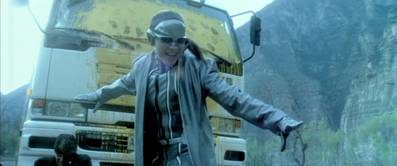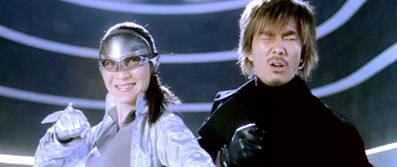|
If
you come to Jingle Ma's Silver Hawk without
any foreknowledge of its content or style as I did, then you are in for a few
surprises, not all of them happy ones. As the film opens,
the delightful Michelle Yeoh, dressed in a silver costume
that even a Power Ranger would only wear to a Halloween
party, and riding a motorbike with Trigger's sense of timing
and loyalty, leaps over the Great Wall of China, kick-boxes
a collection of dressed-in-black villains into surrender,
and saves a stolen Panda from a who-knows-what fate. The
execution is lively but familiar, at least in modern martial
arts terms, and the heart can't help but sink a little
under the weight of 'here we go again', flavoured
with the unmistakable tang of cheese. But as Yeoh stands
triumphant over the defeated bad guys, her first words
are of disappointment that the battle has finished so quickly
and suggests that they fight for another ten minutes,
which prompts the terrified mob to cower behind raised
hands and hurriedly tie themselves up.
So
what is going on here, exactly? I'm glad you asked. Celebrity
businesswoman Lulu leads a secret life as masked crime-fighter
Silver Hawk, whose activities the police are keen to curtail,
presumably because she makes them look inept. Young, self-assured
Detective Rich Man (for real) is charged with the task,
and what do you know, it turns out he and Lulu were school
friends and studied kung-fu together, though Lulu was
always the better fighter and used to sort out the bullies
when they hassled the young Man, much to his embarrassment.
Lulu's mother, meanwhile, wants to pair Lulu off with
Professor Ho Chung, the inventor of a smart new video phone,
who is kidnapped by would-be world conqueror Alexander
Wolfe with the intention of using the phone as a mass
brainwash device. With me so far?

Based
on Xiao Ping's 1940s comic book of the same name, many
of the genre's usual absurdities are paraded here with
a knowing wink. The super-hero's identity is concealed
simply by covering part of her face, and no-one, not even
her most obsessive fan, can guess who she really is, despite
her picture being plastered over the cover of half of the
country's glossy magazines. Wolfe, however, has only to
see both pictures once to work it out (well he is an evil
genius) and even Detective Man susses it well before the
end, though he requires the assistance of a home computer and a graphics program.
That Wolfe is bald and foreign (the only non-oriental
main character) completes the picture, recalling Austin Powers'
Dr. Evil, at least in appearance. Elsewhere, there is an
amusing recognition of genre conventions with an inventively
staged fight in which the goons are suspended on bungee
ropes, providing very visible vertical assistance in a
film that has its share of flying wire work, and Silver
Hawk herself fights with a permanent grin on her face,
battling crime not so much from a sense of social justice but because fighting crime is just such enormous fun.
If
this suggests a sophisticated generic parody then I'm
leading you little astray. The characterisations are, for the most
part, simplistic in the extreme, the plot development is played
out by thumping big numbers, and the level of narrative
sophistication is….well, there isn't any. You're
barely a third of the way in when you realise that this
is essentially kung-fu for kids, Barbie-doll James Bond
targeted at an audience who, at least in the UK, have
ironically been deemed by the BBFC as being too young to see it.
All
of which leaves the film a little stranded. Its fights
are constructed largely in the editing and lack the brutality
and style of recent standard-setter Ong-Bak,
its plot and characters make the average Hollywood actioner
look sophisticated, and many elements are too familiar
to provide much in the way of surprise or spectacle. Which
is a shame, as technically there is plenty to admire,
from the steely blue sheen of the photography and the
antiseptically futuristic sets and (one presumes) locations
to the brisk pace and athletic skills of its acrobatic
lead.
But
almost all of this is effectively sabotaged by Ma's choice
to shoot the film in English, doubtless with an eye on the international market. This decision is in itself not a problem,
but its execution most definitely is. The dialogue is
banal at best, and although voiced in English, it has obviously
been re-dubbed in post, often by voice artists instead of the original performer. This results in some stark
mismatches of face and voice, as a largely asian cast
deliver its lines in accents ranging from 'oh gee' American to 'oh
I say' English. This also plays merry hell with inflection,
providing some odd moments of emphasis: "You CARRY
a badge and I don't!" Lulu says to Man at one point,
suggesting she does have one but keeps leaving it at home.
Even Luke Goss – who helped inflict Bros on us but was rather
imposing as Nomak in Blade II – appears
to have re-voiced himself. All of which makes the English
sound like a bad dub, rendering this move a little pointless
– it's no coincidence that the best scenes are the flashbacks
to the kiddie kung-fu school, which are voiced in Cantonese.

We
are left with an uneven mix, with well shot and edited
action, some inventive moments, and an undeniable energy undermined
by simplistic characters and plotting, some overly bright-eyed
acting and sometimes painful dialogue and post-production
delivery. All of which makes me wonder where the
film is going to find an audience in the UK.
Despite
some hurried research I've been unable to confirm this,
but I'd lay odds that the film was shot digitally on Hi-Definition,
indicated by burnt-out highlights in areas of white and
some detail loss in black areas, though the post-production
filtering is no doubt also a contributor here. Contrast
is good, if a little too strong in places (again this could
be deliberate), and detail is largely pleasing, though there
is a slight softness to the picture that again suggests
a transfer from Hi-Def.
Of
the two surround soundtracks on offer, the DTS track has the edge
over the 5.1, on volume and, less obviously, dynamic range.
Separation is sometimes effectively done. The LFE activity
only really comes into its own in the climax, with some
bum-rattling bass accompanying the inevitable explosions.
The trailer (2:09) is 2.35:1 non-anamorphic
and in fine shape. Surprisingly, they've included some of
that dialogue.
There's
also a non-anamorphic trailer (2:41) for Panna Rittikrai's Born to Fight,
which does a fair old job of selling the film and the action
credentials of its stars.
Finally
there is a rolling slideshow (4:28)
of production stills, which are slowly zoomed in on one
by one to full (anamorphic 16:9) screen, and production
sketches, which disappear too quickly and will not sit bloody
still on screen.
Second
time around I warmed to the film's pleasures more, but with
plot and characters this undeveloped, and sometimes wince-inducing
dialogue and post-dubbing, it's virtually impossible to
embrace the Silver Hawk with anything like
open arms, at least if you're 15 or over. But I still have
a sneaking admiration for any film that suggests you could
take over the world by brainwashing people via their mobile
phones. Give it a go – the job's already half done.
|